The Microsoft Surface Book Review
by Brett Howse on November 10, 2015 8:00 AM ESTBattery Life
I would say the average Ultrabook has around 50 Wh of battery capacity. Some have a bit more, and some have a bit less, but 50 Wh would be a good ballpark figure. The Surface Book has a 70 Wh battery, split into 18 Wh in the Clipboard, and 52 Wh in the base. Combined, it gives the Surface Book more battery capacity than any other Ultrabook. However, as I’ve just discussed in the display section, Microsoft has a high resolution panel that is also based on a traditional amorphous silicon TFT which may impact the battery life.
Since the Surface Book includes a detachable Clipboard, the battery tests have been done with the Surface Book both as a tablet and a notebook. The tablet portion of our testing is with the device in Tablet Mode with the screen detached, leaving just 18 Wh of battery capacity. The Surface Book is intended to be used as a laptop first and foremost, but it’s still important to see what it can deliver away from it’s keyboard base. As always, all of our battery life tests are done with the display at 200 nits, and using the Microsoft Edge browser.
Since we have received both the Core i5-6300U model, as well as the Core i7-6600U model with the discrete NVIDIA GPU, both devices have been put through these tests.
Clipboard Battery Life


Battery life of the Clipboard is about what you would expect. With just 18 Wh of capacity, and a full Ultrabook inside the display, there is no way it would get the 10 hours that we would expect of an ARM based tablet. The Core i7 model has less battery life, which makes sense since its base frequency is a bit higher and overall power consumption should be a bit higher even with standard chip binning from Intel. Video playback is very close on both though, which would be expected since the video is offloaded to fixed function hardware in Skylake.
Notebook Battery Life
On the notebook side, we have two tests. The light test consists of loading four web pages per minute, and can be heavily impacted by display power draw. The CPU mostly sits idle during this test, expect for the brief bursts of work to load the pages. The heavy test ramps up the number of pages loaded, adds in a 1 MB/s file download, and has a movie playing.
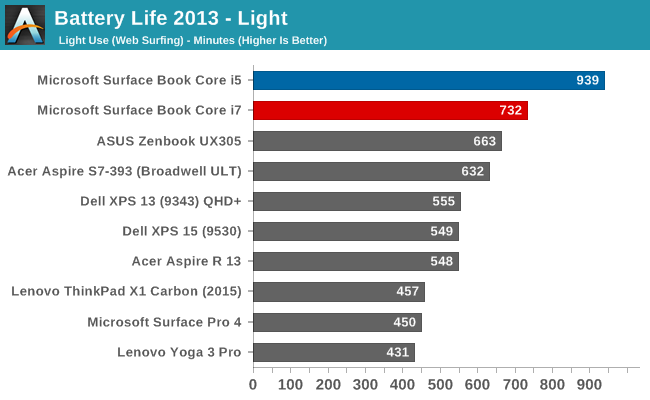
Something amazing happened when I ran the Core i5 Surface Book through our light test. It set a new record for battery life. The amazing part of this is that it did it with a high resolution display, which normally impacts battery life quite a bit. For some contrast, the Dell XPS 13 was our previous battery life leader, but it was the 1920x1080 model. The 3200x1800 version, as seen in the graph above, was quite a bit less. The Core i5 Surface Book got 15.6 hours of battery life in this test. Yes, it was helped by a larger battery, but it was still a very impressive result. The dGPU + Core i7 model took a big hit here, coming in over three hours behind. Without dissecting the device and measuring power draw at each component, it’s tough to lay the blame on any one piece of the puzzle, but it has more RAM, a dGPU with GDDR5 memory (though this should be completely powering down when not in use), and a faster CPU. Any one could be to blame, or a combination of all three. Despite the lower score, at over 12 hours it still did very well on our light test.

The heavy test brings a lot more components into play, making the display power draw a smaller part of the picture. Here we see both the i5 and i7 models doing very well again, but once again the i5 version scores a lot higher. Both models can offer all day battery life, but if outright mobility is a concern, the i5 outperforms the i7 on battery life.
Next, let’s take a look at the platform efficiency, and remove the large 70 Wh of capacity from the equation.
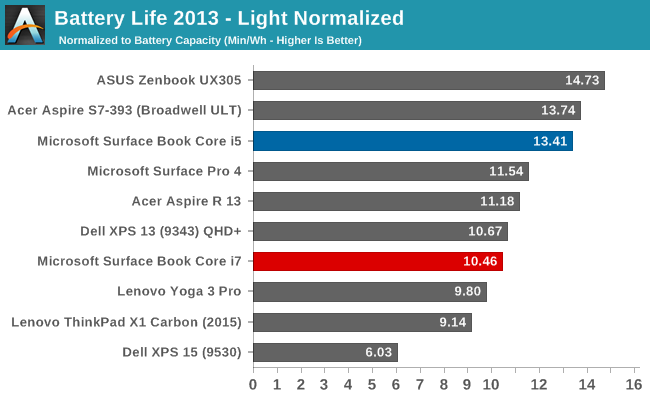
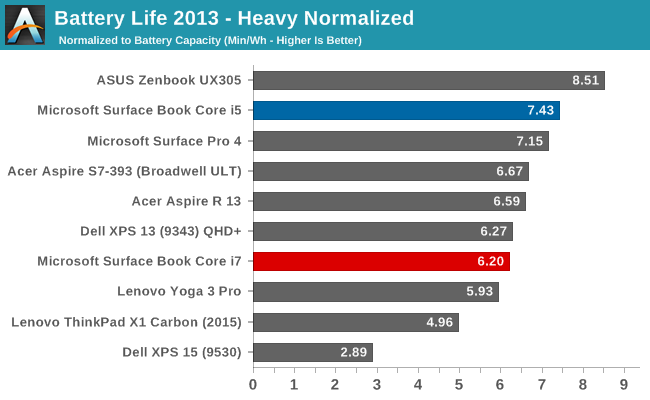
While not the outright leaders in efficiency, the Core i5 Surface Book is the class leader when compared against other high DPI devices. The Core i5 Surface Book has even better efficiency than the Surface Pro 4, despite the Surface Pro 4 using an IGZO panel. On the heavy test, the Core i7 falls back a bit in both tests, but still has a good result.
Connected Standby Support
Surface Book is configured to use Connected Standby, which means that it can pull in app updates and push notifications even when it is sleeping. Out of the box, this is a mixed blessing, since the Surface Book has some issues with Connected Standby at the moment. It is supposed to hibernate after a couple of hours, but that doesn’t always happen, and there seems to be an activity/power drain issue when in sleep, since the Surface Book can get pretty hot when it’s closed. These are serious bugs that mar the experience. You can’t just trust that shutting the lid is going to put the machine to sleep, so if you close the lid and come back the next day, you are going to be welcomed by a dead battery. This is a well known issue, so I would expect a fix soon, but it’s a serious problem with the Surface Book that needs to be pointed out.
Charge Time
With 70 Wh of battery, charge times might be something that will be an issue, so I’ve tested both the Core i5 and the Core i7 models out with their respective adapters that come in the box. Since the Core i7 model includes a GPU, the AC adapter that is supplied is about twice the output of the standard version. The Core i5 comes with a 30 W charger, and GPU models come with a 60 W charger. It’s very difficult to tell which is which, but the 60 W version is slightly thicker, and the charging light on the Surface Connect port has different lighting. The low wattage version has a light that points away from the laptop when connected, and the higher wattage charger has lights that point up and down. You can technically use either charger, or even the Surface Pro 3 or 4 charger, but if you are using the GPU with a 30 W charger, the battery will slowly be depleted since it won’t be able to keep up with demand.
Since there are two batteries, I expected to see the tablet battery charged first and then the base, but that’s not actually what happens. Both are charged simultaneously.
You can see that the 60 W charger on the Core i7 can charge both batteries at the maximum rate simultaneously, but the 30 W charger that comes with the Core i5 charges the smaller tablet battery at maximum first, and when it’s full, sends the rest of the power to the base. It results in a longer charge rate for the non-GPU version.
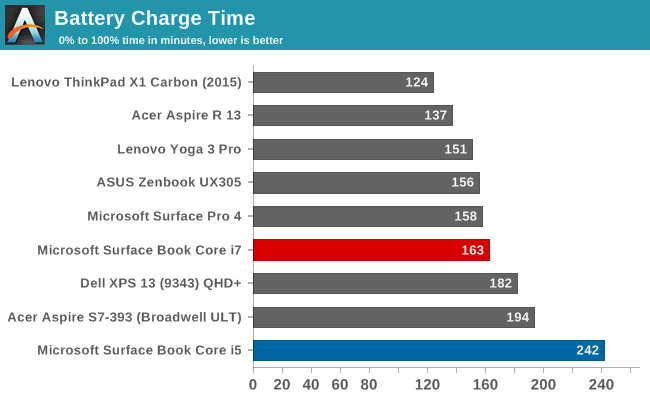
Thanks to including a large 60W power adapter by default, the Core i7 + dGPU version wins by quite a bit, with the non-dGPU model taking nearly four hours to charge to 100% on both batteries. It kind of makes up for that with great battery life, but if you are someone that travels a lot, it may be worth investing in the higher wattage adapter for the non-dGPU version.


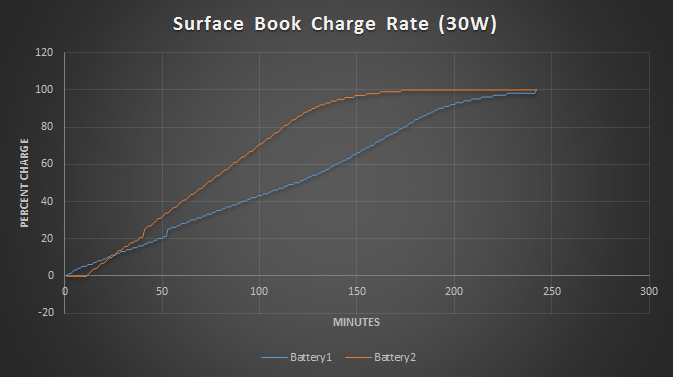
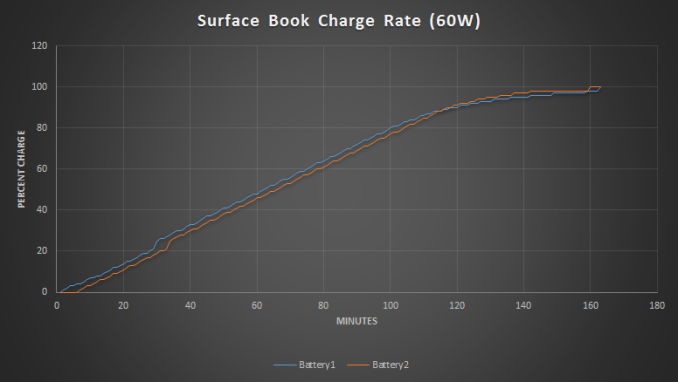








249 Comments
View All Comments
zeeBomb - Thursday, November 12, 2015 - link
Let's go for 200.solipsism - Tuesday, November 10, 2015 - link
Ah, you are correct, djboxbaba.KoolAidMan1 - Tuesday, November 10, 2015 - link
The current 13" Macbook Pros are Broadwell, not Skylake. 28w Skylake parts aren't out until Q1 2016.tipoo - Tuesday, November 10, 2015 - link
Solandri, now you're talking about the 13" MBPs CPU, after giving the 15" with dGPUs pricing...The 15" which we were talking about has a full wattage laptop quad. Your points are starting to look a little suspect as you mix and match a lot. Surface Book without dGPU pricing compared to the upgraded 15" MBP with GPU for price, and then the 13" MBPs CPU when that's convenient to talk about...Look at the Surface Books price WITH the dGPU, which I already specified before, and then match the storage and RAM of the 15" MBP, and the prices start to look similar, except with a quad core vs a dual. And the baseline Iris Pro gets close to the 940M performance as well.
Solandri - Wednesday, November 11, 2015 - link
tipoo, how am I mixing and matching? I looked at the top SB which has a dGPU at $2099, and compared to the top 13" MBP and top 15" MBP (with dGPU), and the SB pricing is closer to the 13" MBP. If you compare models without dGPU, it's even closer to the 13" MBP.Lowest-end 13" rMBP on Apple's website - $1299
Lowest-end SB w/o GPU - $1499
Lowest-end 15" rMBP w/o GPU - $1999
And the Iris Pro 6100 performance doesn't come anywhere near the 940m (except for OpenGL, which is important for OS X, but not for Windows or games). The 940m is roughly 2x as fast.
http://www.notebookcheck.net/Mobile-Graphics-Cards...
http://www.notebookcheck.net/Computer-Games-on-Lap...
Darkstone - Tuesday, November 10, 2015 - link
You can't compare processors with different TDP's by their clock speeds. My 45W CPU isn't able to sustain it's turbo clock under most 100% workloads, on rare workloads it will even drop below it's stock clocks without using the GPU. On those rare workloads it's slower than an on paper lower specced i5 desktop CPU purely because the TDP is higher.The i5-5287U in the MBP will require about 21W to sustain turbo clocks under AVX workloads (according to notebookcheck's stress test). Any 15W part will be significantly slower regardless of what intel claims what the clock speeds are.
Riley-NZL - Tuesday, November 10, 2015 - link
Your also comparing an OSx device with a Windows device, the later being infinetly more valuable regardless of hardware specs :Ptipoo - Tuesday, November 10, 2015 - link
You can run both on the former. But anyways, the value of the OS is subjective per user, that's a meaningless thing to say.theuglyman0war - Wednesday, December 2, 2015 - link
true considering the first thing I do when I demo the newest Surface at the Brick n Mortar is to see how accurate and responsive the pen pressure is.During these arguments I think the army of creative types who hunger for the niche these products offer are hugely ignored.
Billie Boyd - Friday, November 27, 2015 - link
While the Microsoft Surface is truly fantastic , there are higher rated ones, believe it or not (see http://www.consumerrunner.com/top-10-best-tablets/ for example..)